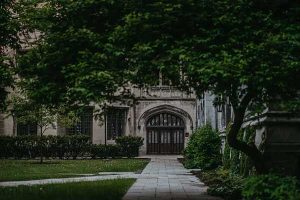 By: Zoë Brockenbrough, Summer 2023 Ethics and Policy Office Intern
By: Zoë Brockenbrough, Summer 2023 Ethics and Policy Office Intern
Arguments about politics, race, and gender. Stalking. Cyberbullying. Online forums and private messages that degenerate into harassment and hate speech. Around 4 in 10 Americans have experienced online harassment, and there have been numerous cases of university faculty becoming part of that 40%. How can universities handle free speech and its limits in the age of the Internet? There is no consensus on how to approach the issue because there is no objective line that can be definitively drawn between what is considered free speech and what is considered online harassment. This is exacerbated by the fact that public and private institutions of higher education are not required to incorporate the First Amendment into their policies the same way. This blog will explore the tension between free speech and online harassment and look at how the issue recently played out at one well-known university.
Of course, it’s not even as simple as “free speech” on one side and “harassment” on the other. The First Amendment is intended to protect freedom of speech, but what falls under the category of “free speech” itself has frequently been a point of contention at all levels of government, including the U.S. Supreme Court. According to Common Sense Media, the definition of online harassment is “when someone uses technology — like cellphones, computers, social media, or gaming platforms — to bully, threaten, or aggressively hassle someone.” While the definition itself is concrete, there is no universally set criteria for what it means to “bully, threaten, or aggressively hassle.” We can observe this nuance in the recent Supreme Court case Counterman v. Colorado, where a 7-2 majority of the Supreme Court ruled that in order to classify speech as unprotected by the First Amendment, the State must “prove that the defendant had some subjective understanding of the statements’ threatening nature.” Aside from analyzing the intent of an act of speech, it’s important to note that the effects of these actions may not remain contained to the Internet but can create real-life repercussions as well. According to a study focusing on the impact of online harassment within Finland’s academic sphere, scholars who are victims of online harassment can experience physical signs of stress, difficulty concentrating, PTSD symptoms, suicidal thoughts, and long-term mental health effects such as anxiety and depression. It can also create challenges from a professional standpoint, such as lower productivity, self-confidence, and job satisfaction. Universities typically have policies stating that harassment is not allowed but are struggling with how to protect their professors while also maintaining the student body’s right to free speech online.
This issue is epitomized by a recent case at the Univeristy of Chicago (“UChicago”), where Professor Rebecca Journey titled an undergraduate seminar that she was teaching “The Problem of Whiteness.” A UChicago student, Daniel Schmidt, who is known as a conservative activist on campus, took issue with the seminar, and posted on Twitter Dr. Journey’s photo and university email address along with the message “Anti-white hatred is now mainstream academic inquiry.” Dr. Journey received a slew of emails from complete strangers that contained concerning threats of violence. Initially, UChicago classified the incident as cyberbullying, but within several months UChicago dismissed Dr. Journey’s complaints. UChicago already has an official guide online for how to respond to online harassment, within which there are four main steps they offer to victims of online harassment: assess the threat, report the incident, preserve and share any relevant evidence, and take care of yourself. The neutral tone of the guide itself represents the dilemma that many universities face, in that choosing to pick sides between the victim and the perpetrator of the online harassment will undoubtedly create backlash, regardless of whose side the university defends. An additional complication is that private universities are not required to uphold First Amendment protections in the same way that public universities do, because they are not classified as government entities. This means private universities can impose stricter limitations on free speech if they choose to, which can include policies addressing speech the private university deems hateful or offensive. The ability of private universities to approach free speech differently than public universities confirms that there is no singular solution for universities when it comes to the regulation of online harassment. However, private universities should still consider the potential public backlash against limitations on speech, even if the limitations are technically legal.
Questions to consider:
- It is a constitutional duty that the freedom of speech be protected but at what point does that become substantially harming others?
- Where the ethical line in the sand for where speech is protected versus where the person is protected?
- Should freedom of speech online be regulated differently than it is in physical spaces like classrooms, auditoriums, etc.?
- Should universities have a priority to protect their faculty over their students, or vice versa?
